Saltzman B. (editor) Anomalous Atmospheric Flows and Blocking
Подождите немного. Документ загружается.

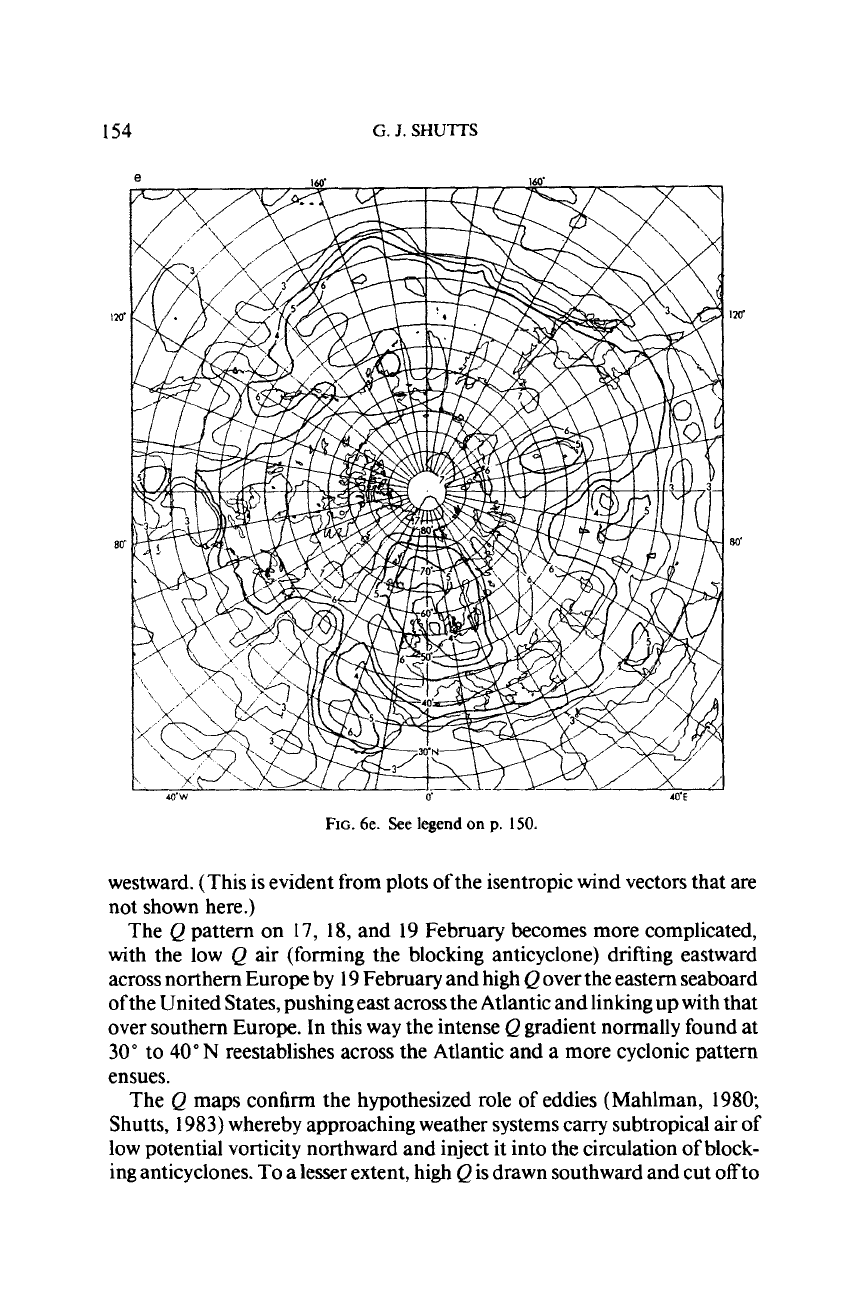
154
G.
J.
SHUTT3
FIG.
6e.
See
legend
on
p.
150.
westward. (This is evident from plots of the isentropic wind vectors that are
not shown here.)
The
Q
pattern on 17, 18, and 19 February becomes more complicated,
with the low
Q
air (forming the blocking anticyclone) drifting eastward
across northern Europe by 19 February and high
Q
over the eastern seaboard
ofthe United States, pushing east across the Atlantic and linking up with that
over southern Europe. In this way the intense
Q
gradient normally found at
30" to
40"
N
reestablishes across the Atlantic and a more cyclonic pattern
ensues.
The
Q
maps confirm the hypothesized role of eddies (Mahlman, 1980;
Shutts, 1983) whereby approaching weather systems carry subtropical air of
low potential vorticity northward and inject it into the circulation of block-
ing anticyclones.
To
a lesser extent, high
Qis
drawn southward and cut
off
to
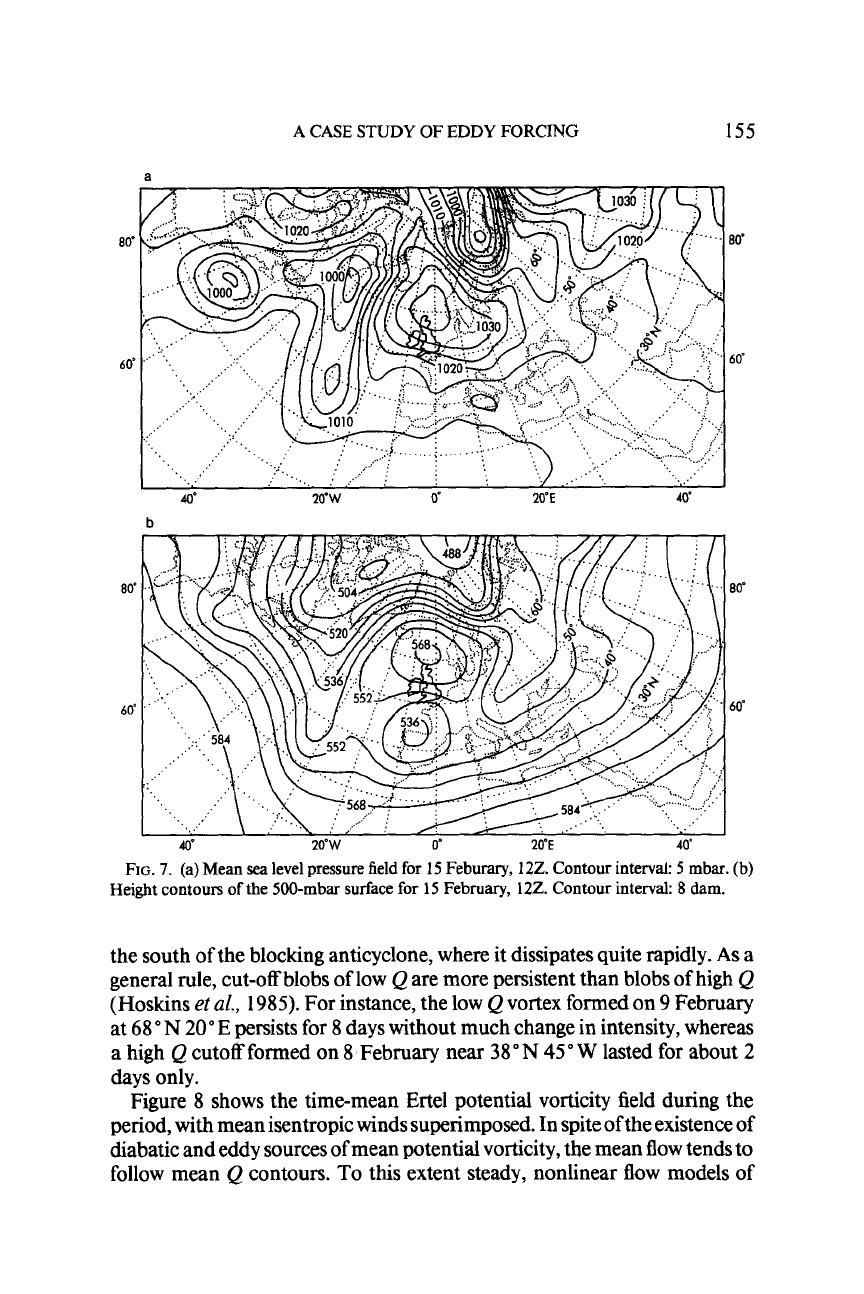
A
CASE STUDY OF EDDY FORCING
155
a
FIG.
7.
(a) Mean sea level pressure field for
15
Feburary,
122.
Contour interval:
5
mbar. (b)
Height contours of the
500-mbar
surface for
15
February,
122.
Contour interval:
8
dam.
the south of the blocking anticyclone, where it dissipates quite rapidly.
As
a
general rule, cut-off blobs of low
Q
are more persistent than blobs of high
Q
(Hoskins
et
al.,
1985).
For instance, the low
Q
vortex formed on
9
February
at
68
ON
20"
E
persists for
8
days without much change in intensity, whereas
a high
Q
cutoff formed on
8
February near
38"
N
45
OW
lasted for about
2
days only.
Figure
8
shows the time-mean Ertel potential vorticity field during the
period, with mean isentropic winds superimposed. In spite of the existence
of
diabatic and eddy sources of mean potential vorticity, the mean flow tends to
follow mean
Q
contours.
To
this extent steady, nonlinear
flow
models of
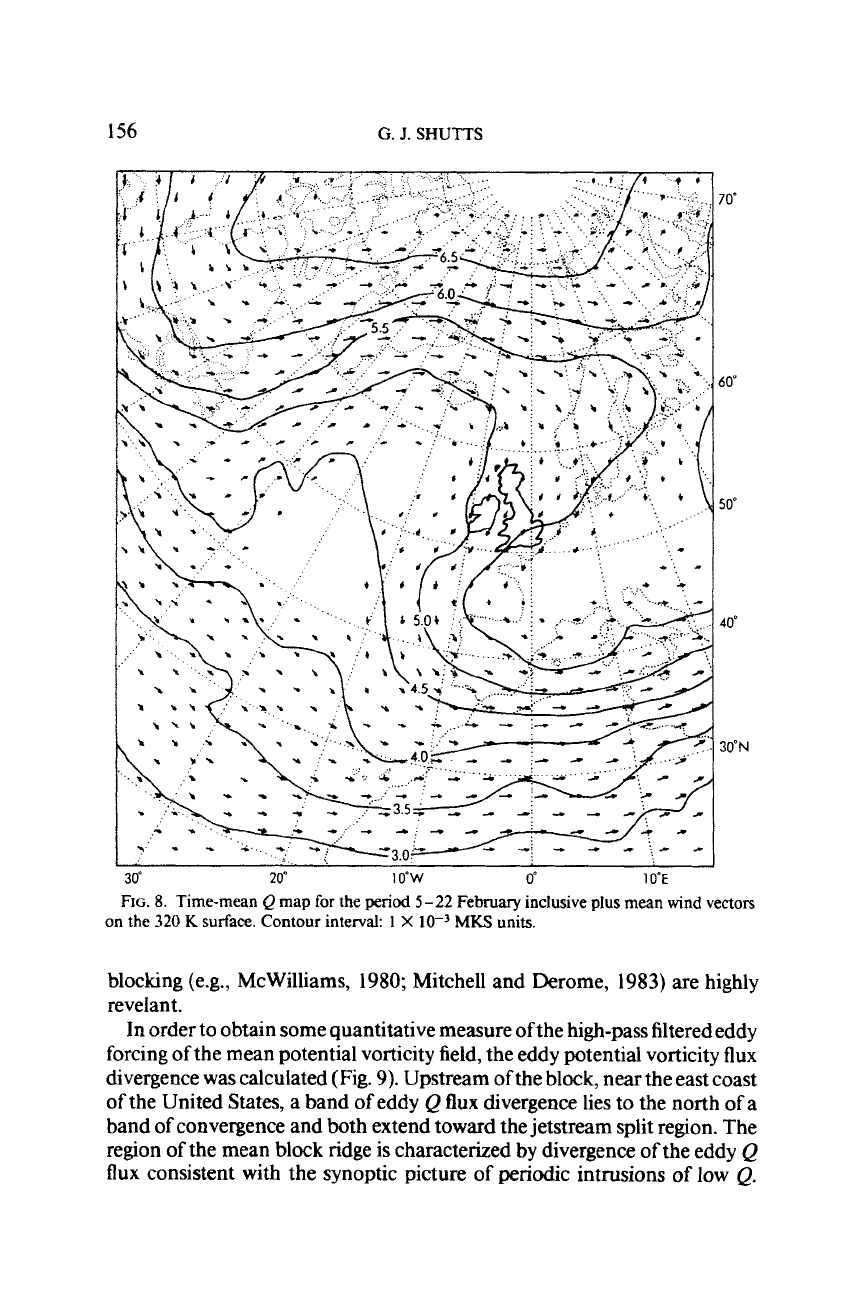
156
G.
J.
SHUTTS
30"
20"
10-w
0"
1O"E
7
0"
60'
50"
40'
30"N
FIG.
8.
Time-mean
Q
map
for
the
period
5-22
February
inclusive plus
mean
wind
vectors
on
the
320
K
surface.
Contour interval:
1
X
lo-)
MU
units.
blocking (e.g., McWilliams,
1980;
Mitchell and Derome,
1983)
are highly
revelant.
In order to obtain some quantitative measure
of
the high-pass filtered eddy
forcing
of
the mean potential vorticity field, the eddy potential vorticity flux
divergence
was
calculated (Fig.
9).
Upstream
of
the block, near the east coast
of
the United States,
a
band
of
eddy
Q
flux divergence lies to the north
of
a
band
of
convergence and both extend toward the jetstream split region. The
region of the mean block ridge is characterized by divergence
of
the eddy
Q
flux consistent with the synoptic picture
of
periodic intrusions
of
low
Q.
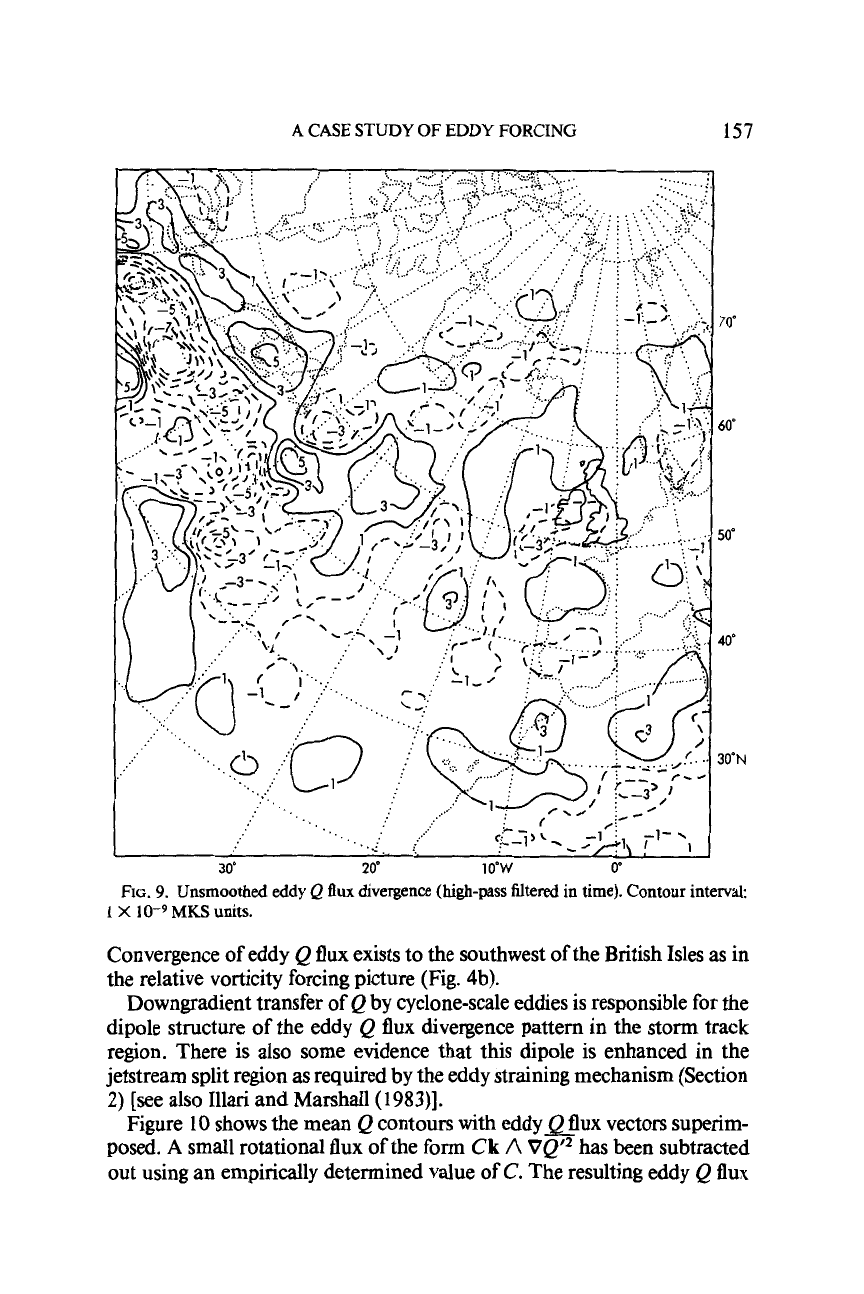
A
CASE STUDY OF EDDY FORCING
157
FIG.
9. Unsmoothed eddy
Q
flux
divergence
(high-pass
filtered
in time). Contour
interval:
1
X
lod9
MKS
units.
Convergence of eddy
Q
flux exists to the southwest
of
the British Isles as in
the relative vorticity forcing picture (Fig. 4b).
Downgradient transfer of
Q
by cyclone-scale eddies is responsible for the
dipole structure of the eddy
Q
flux divergence pattern in the storm track
region. There is also some evidence that this dipole
is
enhanced in the
jetstream split region as required by the eddy straining mechanism (Section
2)
[see also Illari and Marshall
(1
983)].
Figure
10
shows the mean
Q
contours with eddyeflux vectors superim-
posed.
A
small rotational flux
of
the form
Ck
A
VQ’z
has been subtracted
out using an empirically determined value of
C.
The resulting eddy
Q
flux
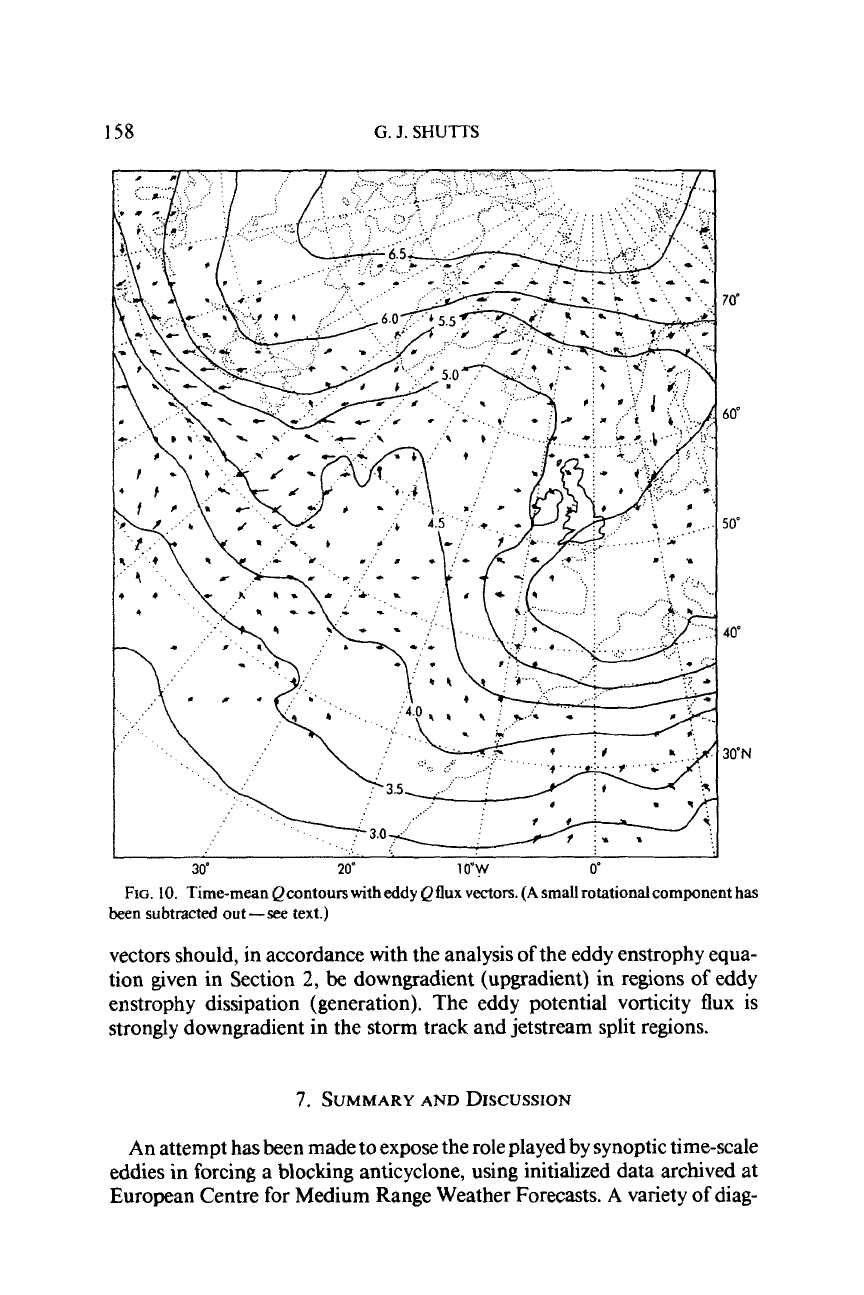
158
G.
J.
SHUTTS
30'
20"
10-w
0'
FIG.
10.
Time-mean Qcontourswitheddy Qflux
vectors.
(A
small
rotational
component has
been subtracted out-see text.)
vectors should, in accordance with the analysis
of
the eddy enstrophy equa-
tion given in Section
2,
be
downgradient (upgradient) in regions
of
eddy
enstrophy dissipation (generation). The eddy potential vorticity flux is
strongly downgradient in the storm track and jetstream split regions.
7.
SUMMARY
AND
DISCUSSION
An attempt
has
been made to expose the role played by synoptic time-scale
eddies in forcing a blocking anticyclone, using initialized data archived at
European Centre
for
Medium Range Weather Forecasts.
A
variety
of
diag-
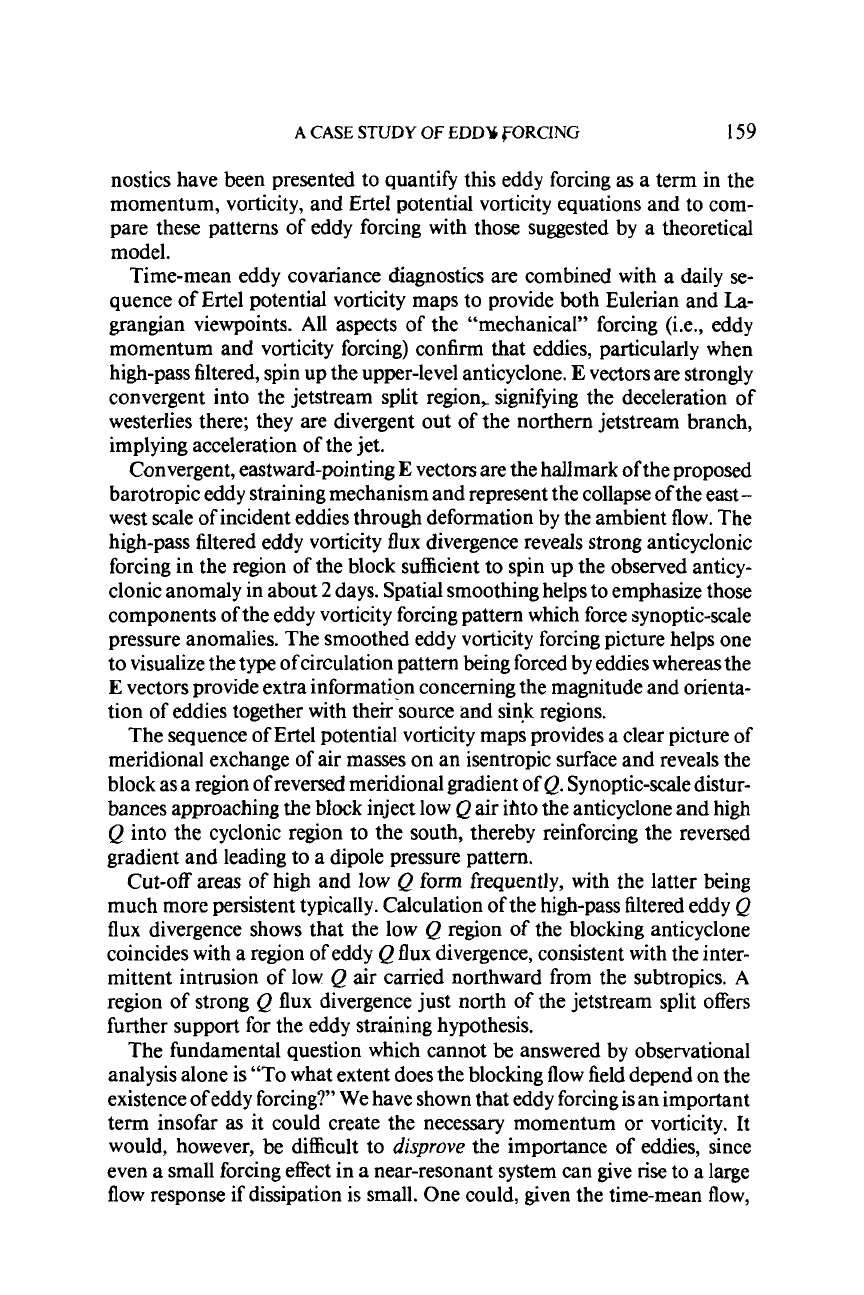
A
CASE
STUDY
OF
EDDY
FORCING
159
nostics have been presented to quantify this eddy forcing
as
a term in the
momentum, vorticity, and Ertel potential vorticity equations and to com-
pare these patterns of eddy forcing with those suggested by a theoretical
model.
Time-mean eddy covariance diagnostics are combined with a daily
se-
quence of Ertel potential vorticity maps to provide both Eulerian and
La-
grangian viewpoints. All aspects of the “mechanical” forcing (i.e., eddy
momentum and vorticity forcing) confirm that eddies, particularly when
high-pass filtered, spin up the upper-level anticyclone.
E
vectors are strongly
convergent into the jetstream split region, signifying the deceleration of
westerlies there; they are divergent out of the northern jetstream branch,
implying acceleration of the jet.
Convergent, eastward-pointing
E
vectors are the hallmark of the proposed
barotropic eddy straining mechanism and represent the collapse of the east
-
west scale of incident eddies through deformation by the ambient flow. The
high-pass filtered eddy vorticity
flux
divergence reveals strong anticyclonic
forcing in the region of the block sufficient to spin up the observed anticy-
clonic anomaly in about
2
days. Spatial smoothing helps to emphasize those
components of the eddy vorticity forcing pattern which force synoptic-scale
pressure anomalies. The smoothed eddy vorticity forcing picture helps one
to visualize the type of circulation pattern being forced by eddies whereas the
E
vectors provide extra information concerning the magnitude and orienta-
tion of eddies together with their‘source and sink regions.
The sequence of Ertel potential vorticity maps provides a clear picture of
meridional exchange of air masses on an isentropic surface and reveals the
block as a region
of
reversed meridional gradient of
Q.
Synoptic-scale distur-
bances approaching the block inject low
Q
air ihto the anticyclone and high
Q
into the cyclonic region to the south, thereby reinforcing the reversed
gradient and leading to a dipole pressure pattern.
Cut-off areas of high and low
Q
form frequently, with the latter being
much more persistent typically. Calculation of the high-pass filtered eddy
Q
flux divergence shows that the low
Q
region of the blocking anticyclone
coincides with a region of eddy
Q
flux divergence, consistent with the inter-
mittent intrusion of low
Q
air camed northward from the subtropics.
A
region of strong
Q
flux divergence just north of the jetstream split offers
further support for the eddy straining hypothesis.
The fundamental question which cannot
be
answered by observational
analysis alone is “To what extent does the blocking flow field depend on the
existence of eddy forcing?” We have shown that eddy forcing is an important
term insofar
as
it could create the necessary momentum or vorticity. It
would, however, be difficult to
disprove
the importance of eddies, since
even a small forcing effect in a near-resonant system can give
rise
to a large
flow response
if
dissipation is small. One could, given the time-mean flow,
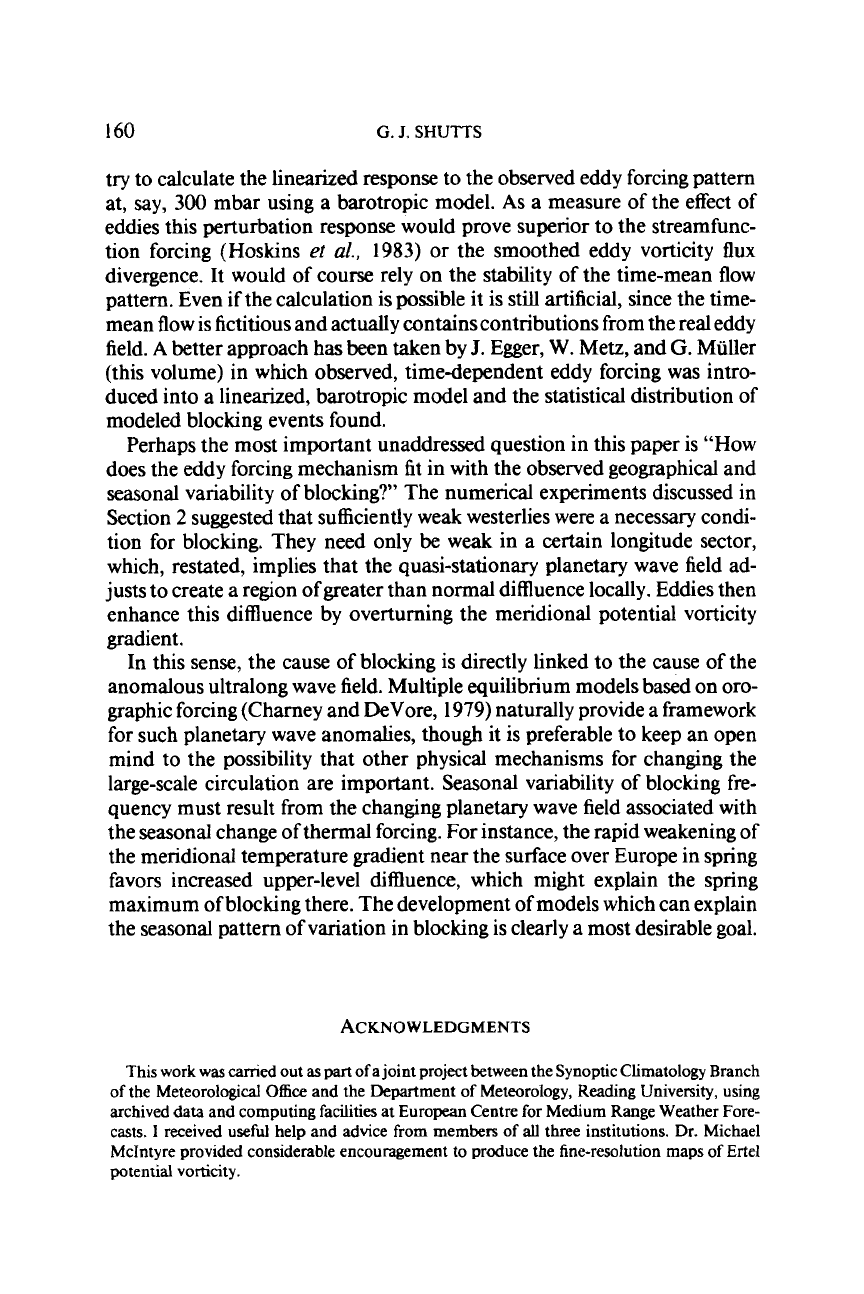
160
G.
J.
SHUlTS
try to calculate the linearized response to the observed eddy forcing pattern
at, say,
300
mbar using a barotropic model.
As
a measure of the effect of
eddies this perturbation response would prove superior to the streamfunc-
tion forcing (Hoskins
et
a!.,
1983)
or the smoothed eddy vorticity flux
divergence. It would of course rely on the stability of the time-mean flow
pattern. Even if the calculation is possible it is still artificial, since the time-
mean flow is fictitious and actually containscontnbutions from the real eddy
field.
A
better approach has been taken by
J.
Egger,
W.
Metz, and
G.
Miiller
(this volume) in which observed, timedependent eddy forcing was intro-
duced into a linearized, barotropic model and the statistical distribution of
modeled blocking events found.
Perhaps the most important unaddressed question in this paper is “How
does the eddy forcing mechanism fit in with the observed geographical and
seasonal variability
of
blocking?’ The numerical experiments discussed in
Section
2
suggested that sufficiently weak westerlies were a necessary condi-
tion for blocking. They need only
be
weak in a certain longitude sector,
which, restated, implies that the quasi-stationary planetary wave field ad-
justs to create a region of greater than normal diffluence locally. Eddies then
enhance this diffluence by overturning the meridional potential vorticity
gradient.
In this sense, the cause of blocking is directly linked to the cause of the
anomalous ultralong wave field. Multiple equilibrium models based on oro-
graphic forcing (Charney and DeVore,
1979)
naturally provide a framework
for such planetary wave anomalies, though it is preferable to keep an open
mind to the possibility that other physical mechanisms for changing the
large-scale circulation are important. Seasonal variability of blocking fre-
quency must result from the changing planetary wave field associated with
the seasonal change of
thermal
forcing. For instance, the rapid weakening of
the meridional temperature gradient near the surface over Europe in spring
favors increased upper-level diffluence, which might explain the spring
maximum of blocking there. The development of models which can explain
the seasonal pattern of variation in blocking is clearly a most desirable goal.
ACKNOWLEDGMENTS
This work was camed out
as
part
of
ajoint project between the Synoptic Climatology Branch
of the Meteorological
05ce
and the Department of Meteorology, Reading University, using
archived
data
and computing facilities at European Centre for Medium Range Weather Fore-
casts.
I
received useful help and advice
from
members
of
all
three institutions.
Dr.
Michael
Mclntyre provided considerable encouragement
to
produce the fine-resolution
maps of
Ertel
potential vorticity.
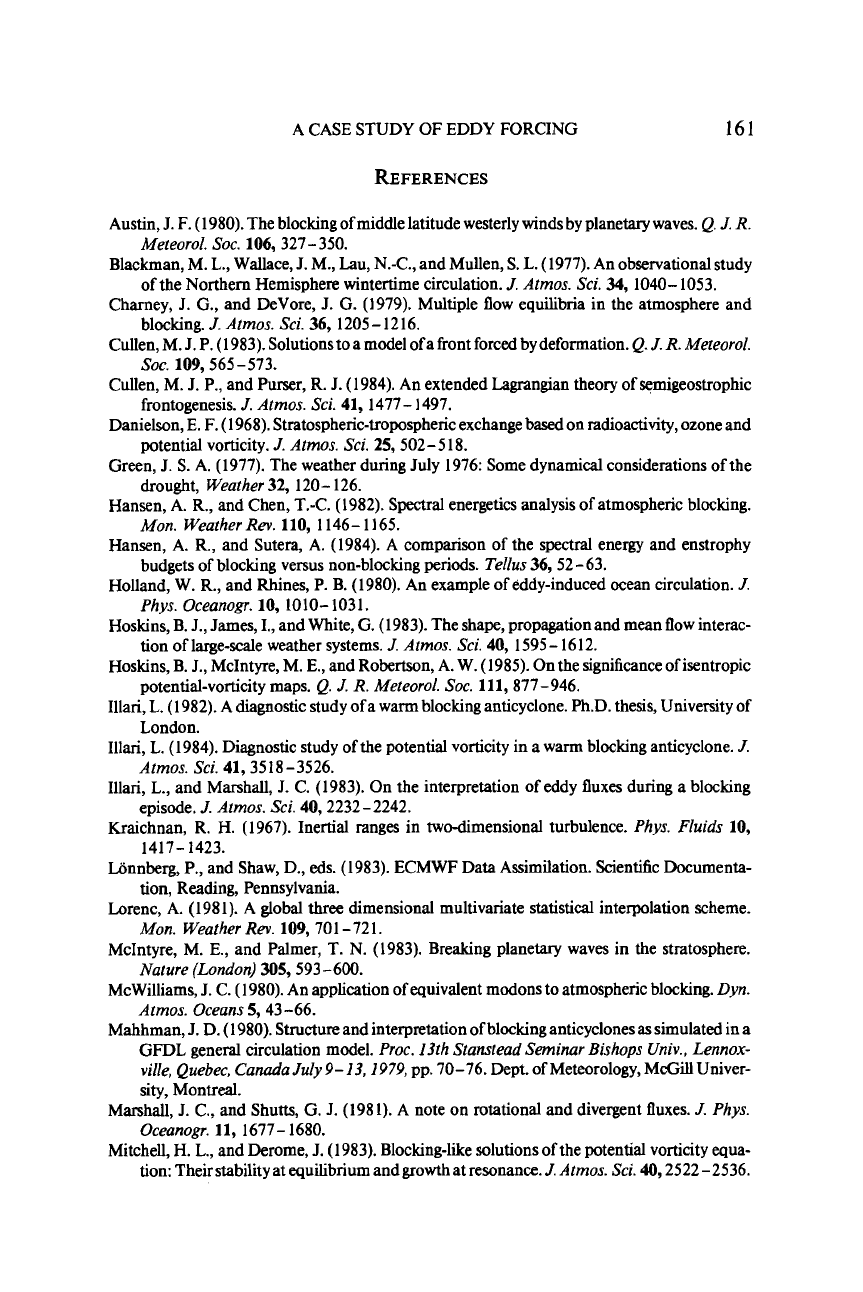
A CASE STUDY
OF
EDDY FORCING
161
REFERENCES
Austin,
J.
F.
(
1980).
The blocking of middle latitude westerly winds by planetary waves.
Q.
J.
R.
Meteorol. SOC.
106,327- 350.
Blackman, M. L., Wallace, J. M.,
Lau,
N.-C., and Mullen,
S.
L.
(1977).
An observational study
of the Northern Hemisphere wintertime circulation.
J.
Atmos. Sci.
34,1040- 1053.
Charney,
J.
G.,
and DeVore,
J.
G.
(1979).
Multiple flow equilibria in the atmosphere and
blocking.
J.
Atmos. Sci.
36, 1205- 1216.
Cullen, M. J.
P.
(
1983).
Solutions to a model of a front forced by deformation.
Q.
J.
R.
Meteorol.
Cullen,
M.
J.
P., and Purser, R. J.
(1
984).
An extended Lagrangian theory of semigeostrophic
Danielson, E.
F.
(1968).
Stratospheric-tropospheric exchange based on radioactivity, ozone and
Green,
J.
S.
A.
(1977).
The weather during July
1976:
Some dynamical considerations
of
the
Hansen,
A.
R.,
and Chen, T.-C.
(1982).
Spectral energetics analysis
of
atmospheric blocking.
Hansen, A.
R.,
and Sutera, A.
(1984).
A comparison of the spectral energy and enstrophy
Holland, W. R., and Rhines,
P.
B.
(1980).
An example of eddy-induced ocean circulation.
J.
Hoskins, B. J., James, I., and White, G.
(1 983).
The shape, propagation and mean flow interac-
Hoskins, B.
J.,
McIntyre, M.
E.,
and Robertson, A. W.
(1985).
On the significance ofisentropic
Illari,
L.
(1982).
A diagnostic study of a warm blocking anticyclone. W.D. thesis, University of
Illari,
L.
(1984).
Diagnostic study of the potential vorticity in a warm blocking anticyclone.
J.
Illari, L., and Marshall,
J.
C.
(1983).
On the interpretation of eddy fluxes during a blocking
Kraichnan, R.
H.
(1967).
Inertial ranges in two-dimensional turbulence.
Phys. Fluids
10,
Lijnnberg,
P.,
and Shaw,
D.,
eds.
(1983).
ECMWF Data Assimilation. Scientific Documenta-
tion,
Reading, Pennsylvania.
Lorenc, A.
(198
1).
A global
three
dimensional multivariate statistical interpolation scheme.
Mon. Weather
Rev.
109, 701
-
72
1.
McIntyre, M. E., and Palmer,
T.
N.
(1983).
Breaking planetary waves in the stratosphere.
Nature (London)
305,593-600.
McWilliams, J.
C.
(1980).
An application of equivalent modons to atmospheric blocking.
Dyn.
Atmos. Oceans
5,43-66.
Mahhman,
J.
D.
(1980).
Structure and interpretation of blocking anticyclones
as
simulated in a
GFDL general circulation model.
Proc. 13th Stanstead Seminar Bishops Univ.. Lennox-
ville, Quebec, Canada July
9-
13,1979,
pp.
70-76.
Dept. ofMeteorology, McGfiUniver-
sity,
Montreal.
Marshall,
J.
C.,
and
Shutts, G.
J.
(198
1).
A note on rotational and divergent fluxes.
J.
Phys.
Oceanogr.
11, 1677- 1680.
Mitchell, H. L., and Derome,
J.
(1
983).
Blocking-like solutions of the potential vorticity equa-
tion: Theirstability at equilibrium and growth at resonance.
J.
Atmos. Scz.
40,2522 -2536.
SOC.
109,565-573.
frontogenesis.
J.
Atmos. Sci.
41, 1477- 1497.
potential vorticity.
J.
Atmos. Sci.
25,
502-5
18.
drought,
Weather
32, 120- 126.
Mon.
Weather
Rev.
110, 1146- 1165.
budgets of blocking versus non-blocking periods.
Tellus
36,52
-
63.
Phys. Oceanogr.
10, 1010-1031.
tion of large-scale weather systems.
J.
Atmos. Sci.
40, 1595
-
16 12.
potential-vorticity maps.
Q.
J.
R.
Meteorol. SOC.
111,877-946.
London.
Atmos. Sci.
41,3518-3526.
episode.
J.
Atmos. Sci.
40,2232-2242.
1417- 1423.
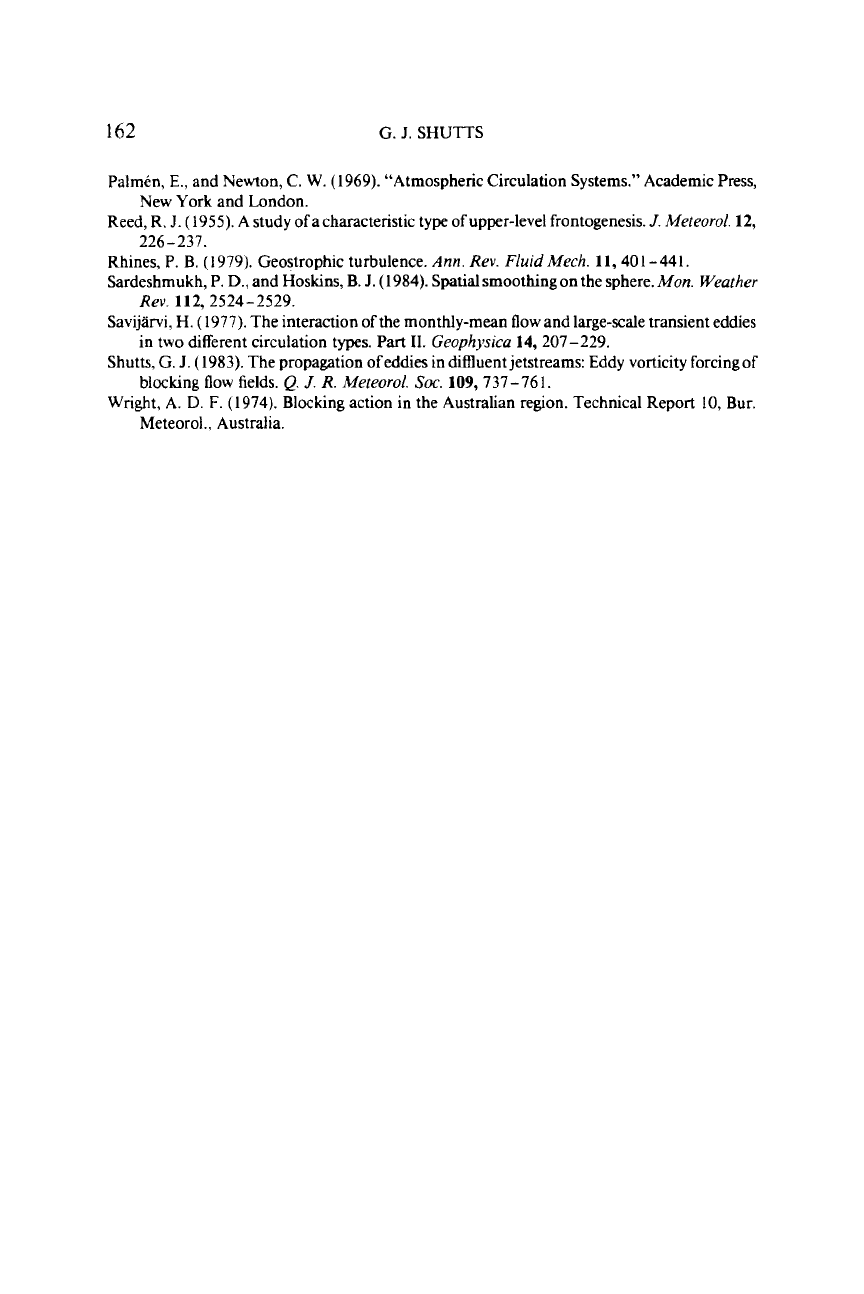
162
G.
J.
SHUTTS
Palmen,
E.,
and Newton,
C.
W. (1969). “Atmospheric Circulation Systems.” Academic Press,
Reed,
R.
J.
(1955).
A
study ofa characteristic type
of
upper-level frontogenesis.
J.
Meteurul.
12,
Rhines,
P.
B.
(1979). Geostrophic turbulence.
Ann.
Rev. Fluid Mech.
11,401 -441.
Sardeshmukh,
P.
D.,
and
Hoskins,
B.
J.
(1984).
Spatial smoothingon the sphere.
Mon.
Weather
Savijarvi,
H.
(
1977). The interaction ofthe monthly-mean flow and large-scale transient eddies
Shutts,
G.
J.
(
1983). The propagation ofeddies in diffluent jetstreams: Eddy vorticity forcing
of
Wright, A.
D.
F.
(1974). Blocking action in the Australian region. Technical Report
10,
Bur.
New York and London.
226-237.
Rev.
112,2524-2529.
in two different circulation types.
Part
11.
Geuphysica
14,
207-229.
blocking flow fields.
Q.
J.
R. Meteorol.
Soc.
109,
737-761.
Meteorol., Australia.
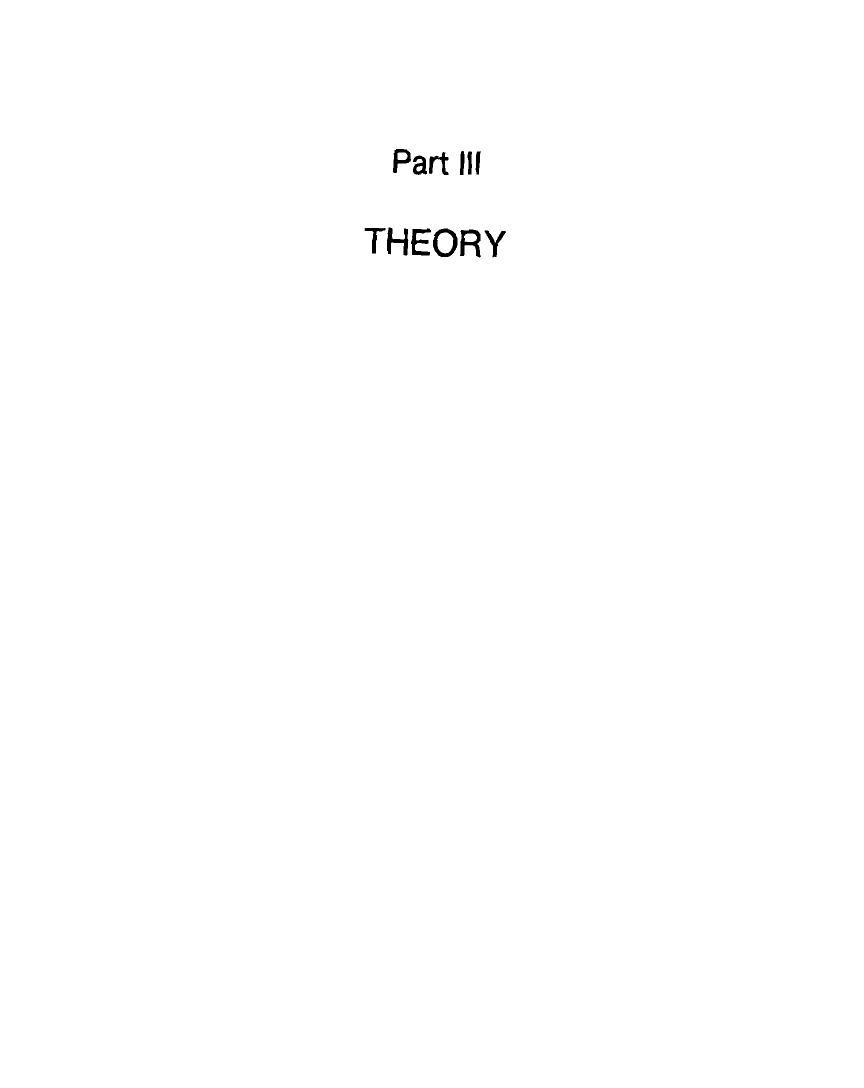
Part
111
TH€ORY
